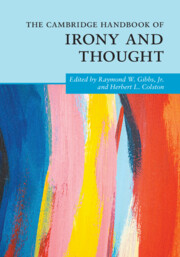Book contents
- The Cambridge Handbook of Irony and Thought
- Cambridge Handbooks in Psychology
- The Cambridge Handbook of Irony and Thought
- Copyright page
- Contents
- Contributors
- Part I Introduction
- Part II The Scope of Irony
- Part III Irony’s Impact
- Part IV Irony in Linguistic Communication
- Part V Irony, Affect, and Related Figures
- 14 Irony and Humor
- 15 Emotional Responses to Sarcasm
- 16 Irony, Exaggeration, and Hyperbole: No Embargo on the Cargo!
- 17 Irony and Its Overlap with Hyperbole and Understatement
- 18 Irony and Satire
- 19 Hypocrisy and Situational Irony
- Part VI Irony in Expressive, Nonlinguistic Media
- Index
- References
16 - Irony, Exaggeration, and Hyperbole: No Embargo on the Cargo!
from Part V - Irony, Affect, and Related Figures
Published online by Cambridge University Press: 20 December 2023
- The Cambridge Handbook of Irony and Thought
- Cambridge Handbooks in Psychology
- The Cambridge Handbook of Irony and Thought
- Copyright page
- Contents
- Contributors
- Part I Introduction
- Part II The Scope of Irony
- Part III Irony’s Impact
- Part IV Irony in Linguistic Communication
- Part V Irony, Affect, and Related Figures
- 14 Irony and Humor
- 15 Emotional Responses to Sarcasm
- 16 Irony, Exaggeration, and Hyperbole: No Embargo on the Cargo!
- 17 Irony and Its Overlap with Hyperbole and Understatement
- 18 Irony and Satire
- 19 Hypocrisy and Situational Irony
- Part VI Irony in Expressive, Nonlinguistic Media
- Index
- References
Summary
Hyperbole is a trope with close relations to irony. People use hyperbole to overly exaggerate the reality of some situation, which implicitly communicates their attitudes toward that topic or event. Barnden specifically argues that hyperbole is another example of “irony-as-affect-expression” in which a hyperbolic statement, such as “Peter has millions of pets,” is not an exaggeration about the number of pets Peter owns, but exaggerates the discrepancy between what some person believes about Peter’s pets and the number of pets Peter really owns. In this manner, hyperbole increases the intensity of “the affect cargo” (e.g., the speaker’s affective purpose in saying “Peter has millions of pets”) beyond that of the cargo (e.g., the actual number of Peter’s pets), which could have been expressed by a nonexaggerating utterance (e.g., “Peter has many pets”). Barnden considers several types of “affect types in ironic cargo,” including contempt, bitterness, criticism, teasing, as well as annoyance, disappointment, regret, relief, and gladness. More generally, irony, including hyperbole, offers far more potential for expressing complex affective states than does nonirony.
Keywords
- Type
- Chapter
- Information
- The Cambridge Handbook of Irony and Thought , pp. 272 - 309Publisher: Cambridge University PressPrint publication year: 2023



